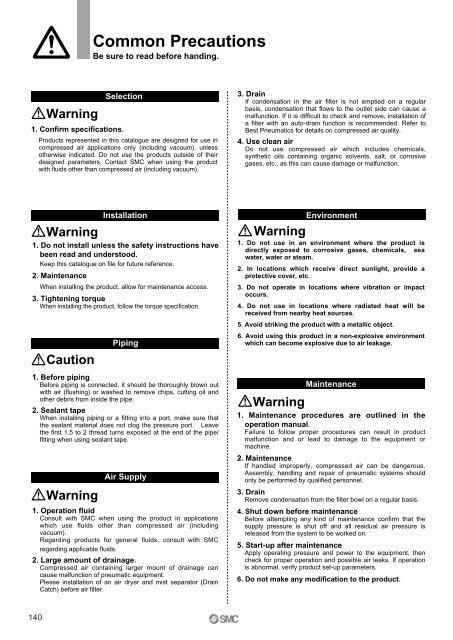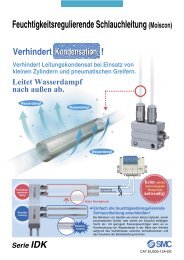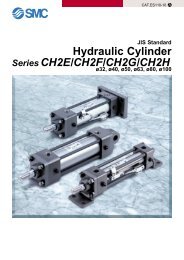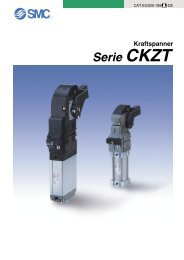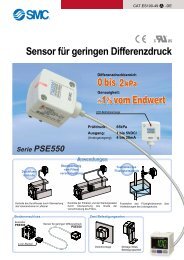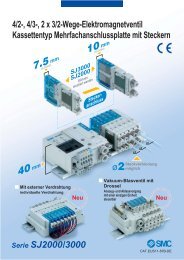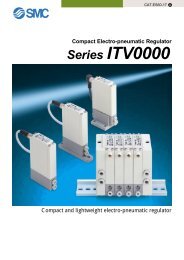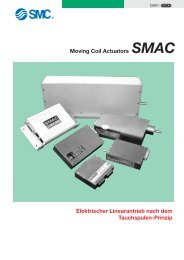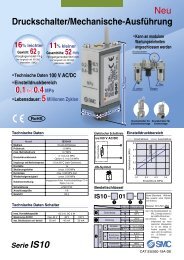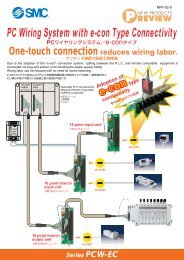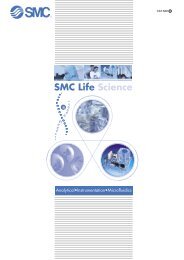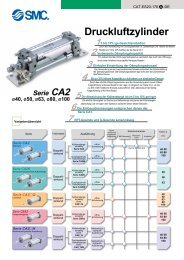ATEX compliant - SMC
ATEX compliant - SMC
ATEX compliant - SMC
You also want an ePaper? Increase the reach of your titles
YUMPU automatically turns print PDFs into web optimized ePapers that Google loves.
Warning<br />
1. Confirm specifications.<br />
Warning<br />
Caution<br />
Warning<br />
Common Precautions<br />
Be sure to read before handing.<br />
Selection<br />
Products represented in this catalogue are designed for use in<br />
compressed air applications only (including vacuum), unless<br />
otherwise indicated. Do not use the products outside of their<br />
designed parameters. Contact <strong>SMC</strong> when using the product<br />
with fluids other than compressed air (including vacuum).<br />
Installation<br />
1. Do not install unless the safety instructions have<br />
been read and understood.<br />
Keep this catalogue on file for future reference.<br />
2. Maintenance<br />
When installing the product, allow for maintenance access.<br />
3. Tightening torque<br />
When installing the product, follow the torque specification.<br />
Piping<br />
1. Before piping<br />
Before piping is connected, it should be thoroughly blown out<br />
with air (flushing) or washed to remove chips, cutting oil and<br />
other debris from inside the pipe.<br />
2. Sealant tape<br />
When installing piping or a fitting into a port, make sure that<br />
the sealant material does not clog the pressure port. Leave<br />
the first 1.5 to 2 thread turns exposed at the end of the pipe/<br />
fitting when using sealant tape.<br />
Air Supply<br />
1. Operation fluid<br />
Consult with <strong>SMC</strong> when using the product in applications<br />
which use fluids other than compressed air (including<br />
vacuum).<br />
Regarding products for general fluids, consult with <strong>SMC</strong><br />
regarding applicable fluids.<br />
2. Large amount of drainage.<br />
Compressed air containing larger mount of drainage can<br />
cause malfunction of pneumatic equipment.<br />
Please installation of an air dryer and mist separator (Drain<br />
Catch) before air filter.<br />
140<br />
3. Drain<br />
If condensation in the air filter is not emptied on a regular<br />
basis, condensation that flows to the outlet side can cause a<br />
malfunction. If it is difficult to check and remove, installation of<br />
a filter with an auto-drain function is recommended. Refer to<br />
Best Pneumatics for details on compressed air quality.<br />
4. Use clean air<br />
Do not use compressed air which includes chemicals,<br />
synthetic oils containing organic solvents, salt, or corrosive<br />
gases, etc., as this can cause damage or malfunction.<br />
Warning<br />
Warning<br />
Environment<br />
1. Do not use in an environment where the product is<br />
directly exposed to corrosive gases, chemicals, sea<br />
water, water or steam.<br />
2. In locations which receive direct sunlight, provide a<br />
protective cover, etc.<br />
3. Do not operate in locations where vibration or impact<br />
occurs.<br />
4. Do not use in locations where radiated heat will be<br />
received from nearby heat sources.<br />
5. Avoid striking the product with a metallic object.<br />
6. Avoid using this product in a non-explosive environment<br />
which can become explosive due to air leakage.<br />
Maintenance<br />
1. Maintenance procedures are outlined in the<br />
operation manual.<br />
Failure to follow proper procedures can result in product<br />
malfunction and or lead to damage to the equipment or<br />
machine.<br />
2. Maintenance<br />
If handled improperly, compressed air can be dangerous.<br />
Assembly, handling and repair of pneumatic systems should<br />
only be performed by qualified personnel.<br />
3. Drain<br />
Remove condensation from the filter bowl on a regular basis.<br />
4. Shut down before maintenance<br />
Before attempting any kind of maintenance confirm that the<br />
supply pressure is shut off and all residual air pressure is<br />
released from the system to be worked on.<br />
5. Start-up after maintenance<br />
Apply operating pressure and power to the equipment, then<br />
check for proper operation and possible air leaks. If operation<br />
is abnormal, verify product set-up parameters.<br />
6. Do not make any modification to the product.


